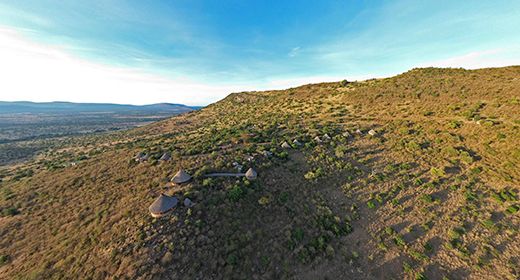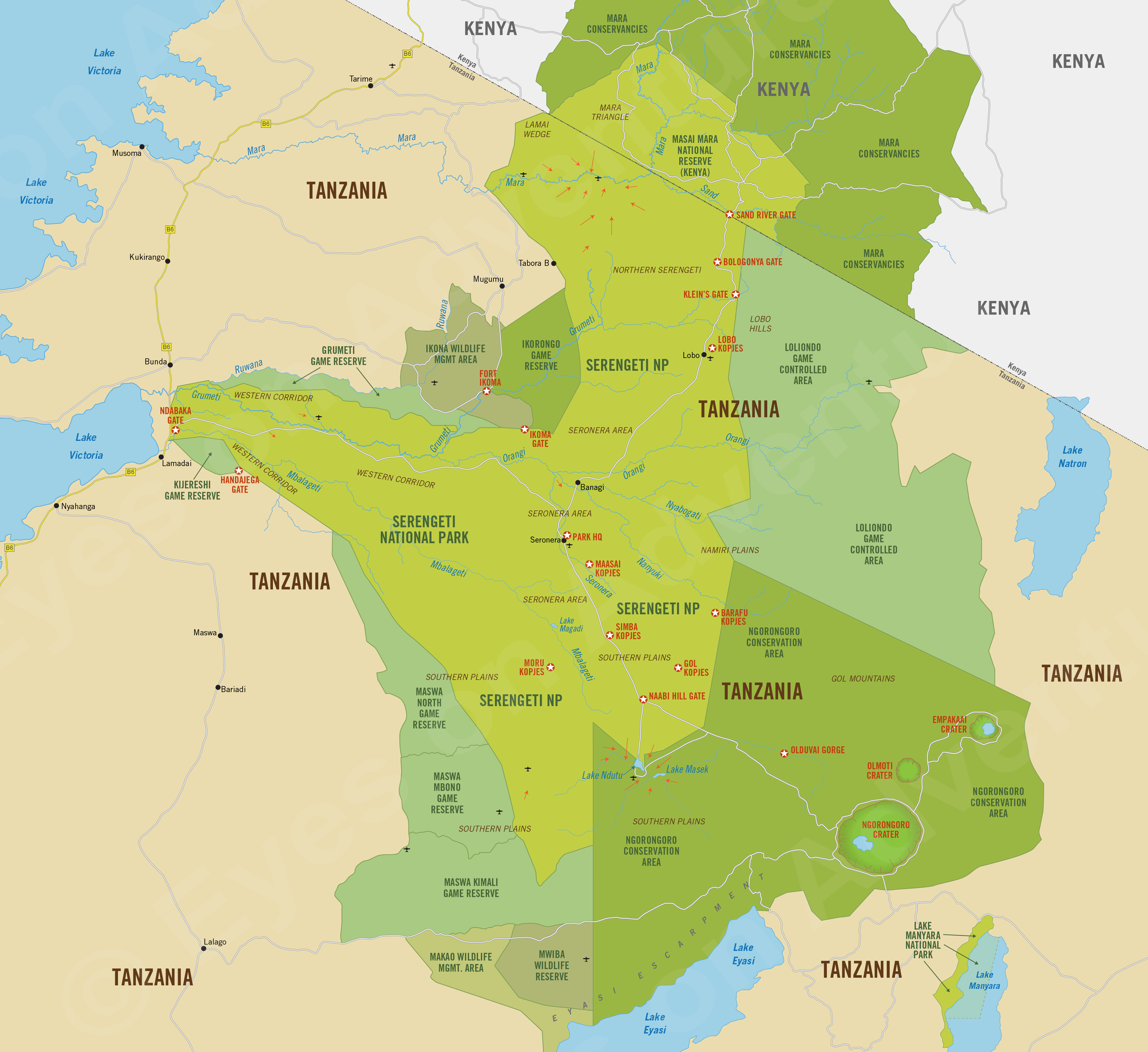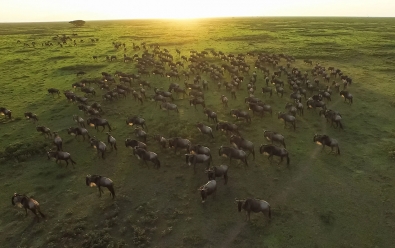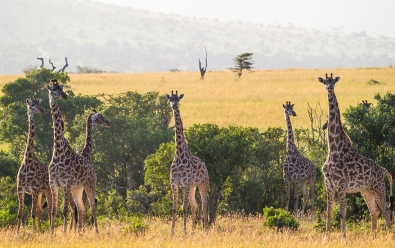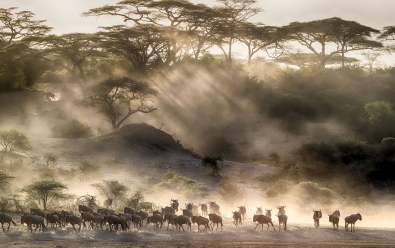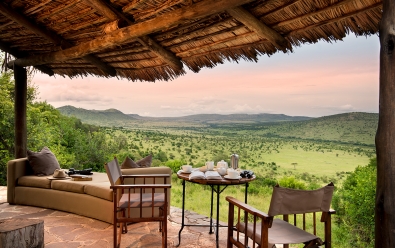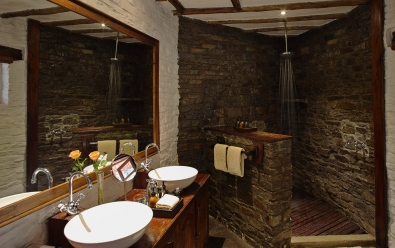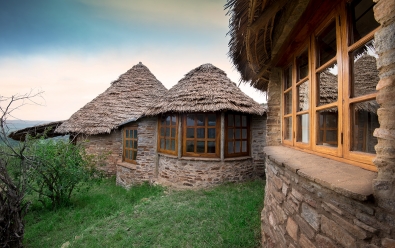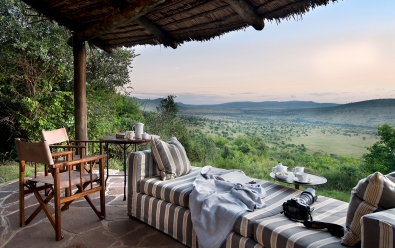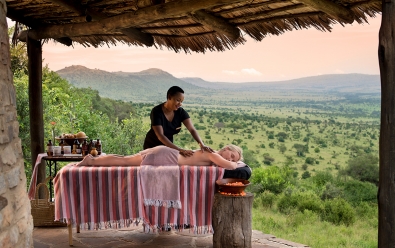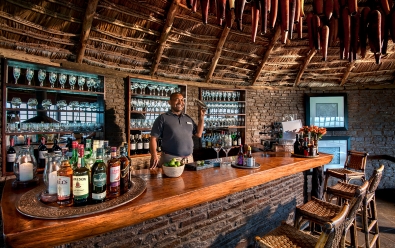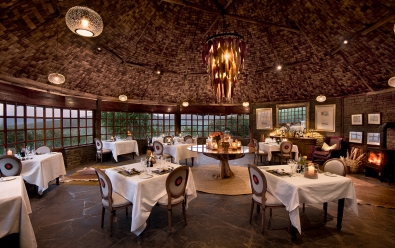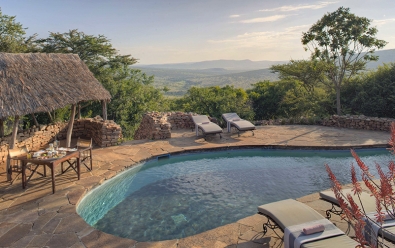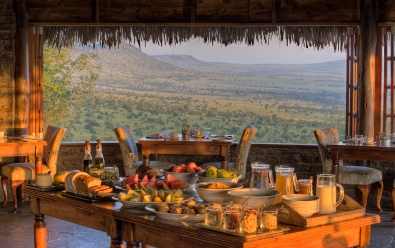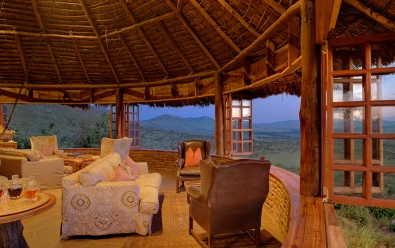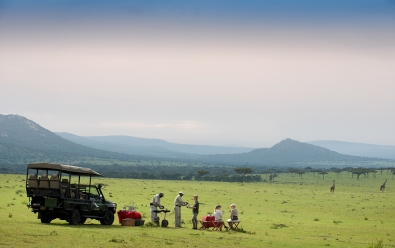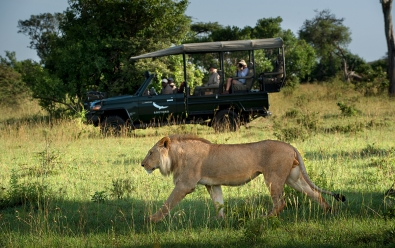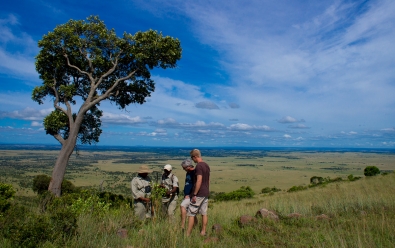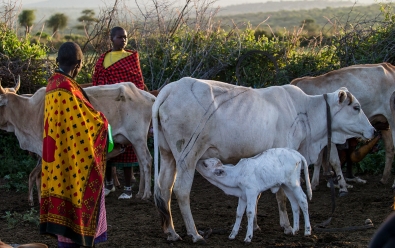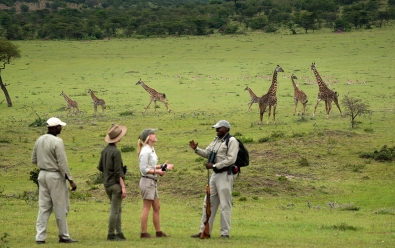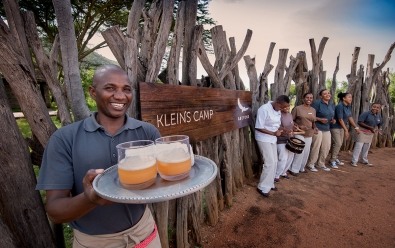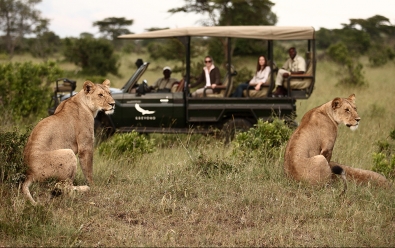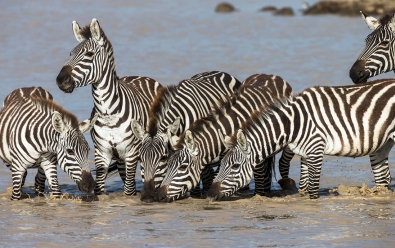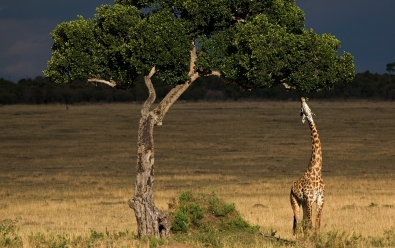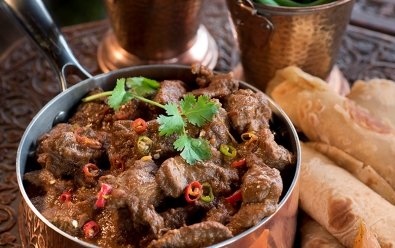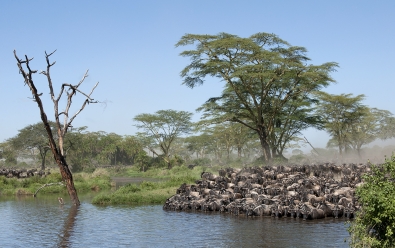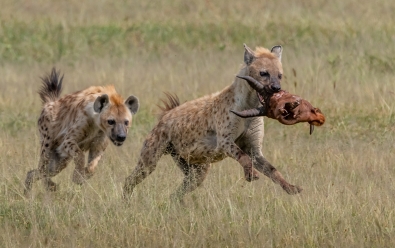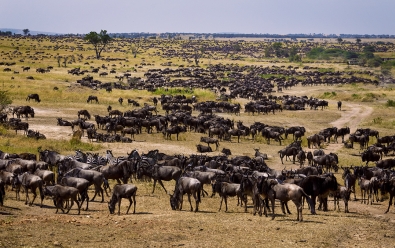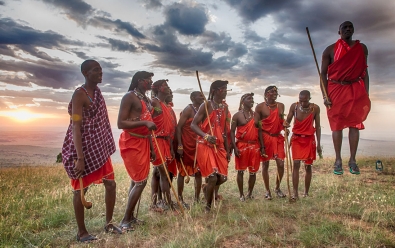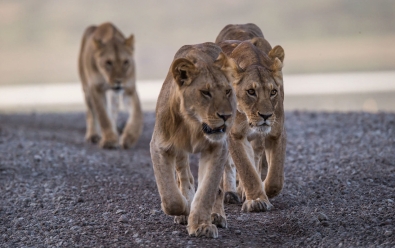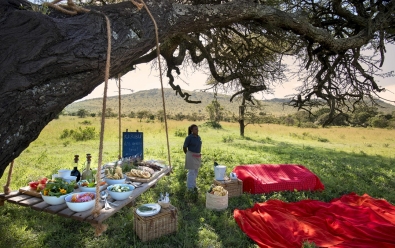Klein's Camp
Location
- Loliondo Game Controlled Area
- Greater Serengeti (Northern)
- Northern Tanzania
Klein's Camp is located in a private concession on the edge of the Kuka Hills, with incredible views all the way to the Masai Mara in Kenya.
The camp enjoys exclusive use of a private land concession covering 39 square miles (100 square kms) that borders both the Serengeti National National Park to the west and Kenya's Masai Mara Game Reserve to the north.
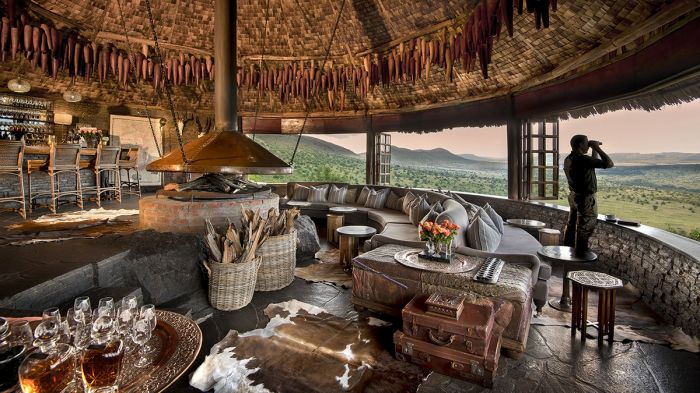
The bar and lounge area at Klein's Camp.
The camp sits high atop one of the Kuka Hills and offers arguably the best panoramic views of any camp in the Greater Serengeti, with a picturesque landscape of wooded hills, rolling grasslands, and riparian forests along several rivers.
The camp also lies directly in the path of the iconic Great Migration of over two million herbivores, one of the greatest spectacles in the natural world.
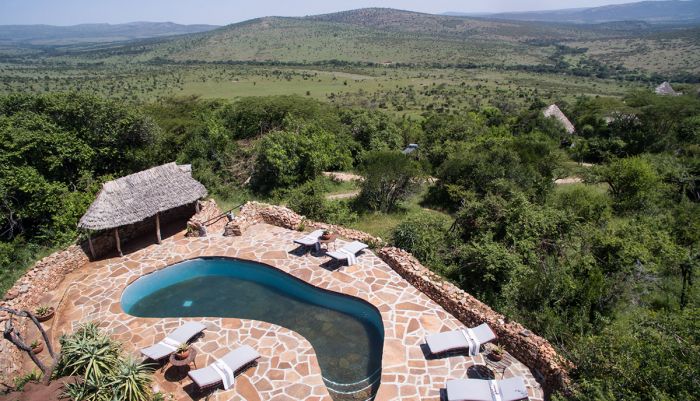
The swimming pool offers fabulous views.
Activities at Klein's Camp include safari drives (including optional night drives to enjoy nocturnal wildlife activity), guided bush walks, and cultural visits to a Maasai village. As the camp is located just outside the national park, sensitive off-road driving is permitted to allow for close wildlife viewing for big cats and other special sightings. The private concession enjoys regular lion pride sightings and because this is the only camp in the area, there are never other vehicles around.
Klein's Camp offers 10 quaint guest cottages built from local stone and with 'makuti-palm' thatched roofs. The comfortable cottages have rich wooden floors and classic East African décor. Two of the cottages are connected by an interior passage which can be opened, creating a perfect double-cottage that is great for a family or two couples traveling together.
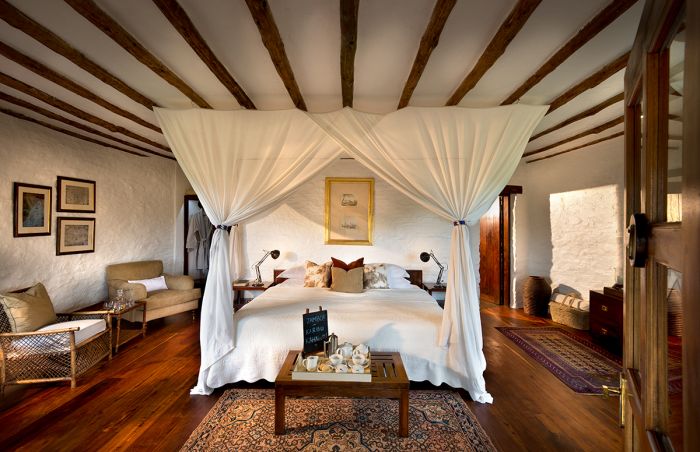
Guest cottage bedroom.
The camp's main area reflects the ruggedly beautiful landscape of the Kuka Hills with its vintage safari style. The stone interiors of the guest areas open up to breathtaking panoramas, with open fireplaces to keep the chill away. There are two beautifully furnished main buildings, one with a bar and lounge and the other used for dining. Outdoor areas include a traditional boma and a swimming pool that offers spectacular vistas into the valley and hills beyond.
Many of the the staff members at Klein’s Camp are Maasai and over 90% of them hail from the surrounding communities. Guests will be able to enjoy learning about the Maasai culture by merely speaking to their safari guide. The staff are all warm and friendly and a visit to the camp will surely inspire anyone with an interest in this ancient and fascinating culture.
For guests with an interest in learning more about the Maasai traditions and their ancient way of living, the camp offers guided visits to a Maasai boma or the local Maasai community, including a school and clinic, which will provide an understanding of the challenges of contemporary Maasai life.
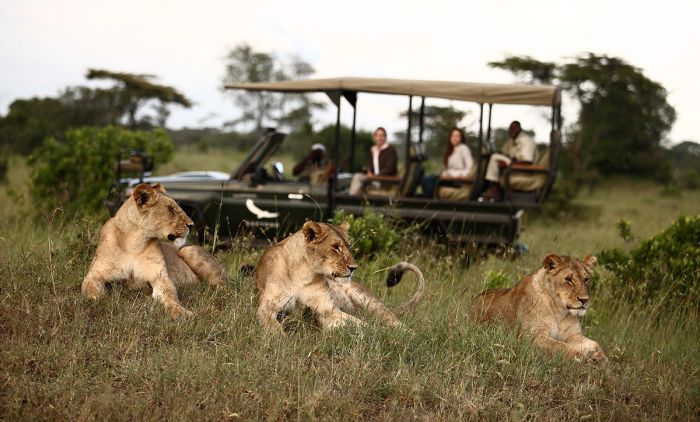
Lions are seen regularly at Klein's Camp.
About the Serengeti
The Greater Serengeti is part of an extensive ecosystem that includes Serengeti National Park, the Ngorongoro Conservation Area, and other reserves, wildlife management areas, and game controlled areas.
The Greater Masai Mara (directly to the north in Kenya) includes the Masai Mara National Reserve, as well as numerous private Mara conservancies. Together, the combined Greater Serengeti-Mara ecosystem, which combines the areas described above, covers roughly 15 000 square miles (39 000 sq kms).
The Serengeti-Mara is home to a very large number and diversity of wild animals and is also the location of the well-known "Great Migration" of over 2 million herbivores (read more below). This is arguably Africa's greatest overall wildlife destination.
Wildlife densities in the Greater Serengeti are some of the highest in Africa, with commonly seen herbivores including blue wildebeest, plains zebra, Thomson's gazelle, topi, Grant's gazelle, hartebeest, giraffe, elephant, buffalo, impala, waterbuck, bushbuck, warthog, and many others. Predators seen often include lion, leopard, spotted hyena, cheetah, serval, and jackal. Hippo and crocodile are found in large numbers in the larger rivers, including the Mara River and the Grumeti River.
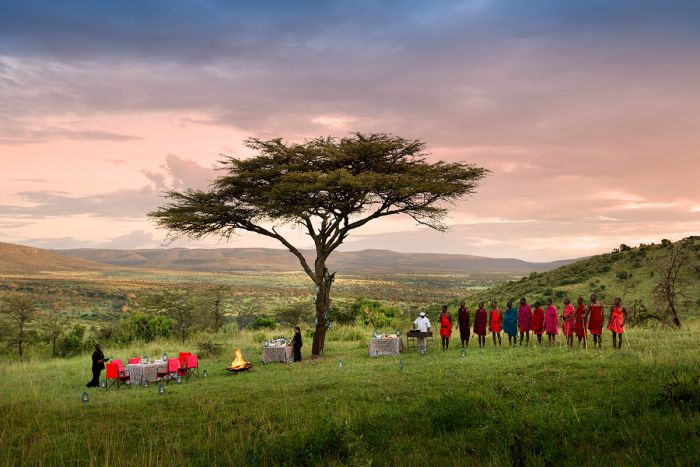
Klein's Camp is one of the best places to experience the Maasai culture.
About the Northern Serengeti
The northern sector of Serengeti National Park is characterized by dense Acacia woodlands interspersed with rolling grassland and some areas of riparian forest along the various waterways, including the Mara River.
Some parts of the migration are present in the northern Serengeti between June and October and resident wildlife viewing is generally good all year. Most of the Serengeti's elephants are found in the north, and there are also good resident numbers of zebra, buffalo, warthog, and gazelle.
The Lobo area is very good for wildlife from late-September through October when the wildebeest and zebra migration passes through on its way back south from Kenya, heading towards the southern plains. Lobo Kopjes, a group of huge granite boulders, is a favorite hangout for prides of lions and also attracts leopards, spotted hyenas, and sometimes cheetahs.
Most of the safari camps are situated along or very near to the Mara River, which becomes the focal point of action when the migration arrives sometime around August. The drama unfolds when the herds congregate and eventually cross en masse with plenty of huge and hungry crocodiles in wait.
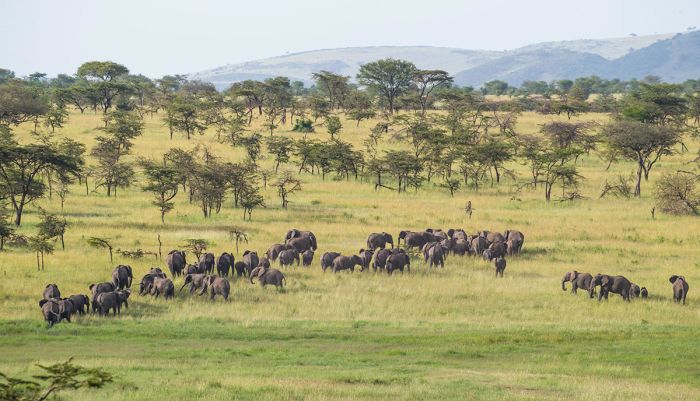
Elephants in the Klein's Camp concession.
The Great Migration
One of nature's greatest living spectacles is the Great Migration, a term given to describe the year-long, circular, clockwise march of over two million herbivores across the Serengeti and Masai Mara grasslands. The migration animals are made up entirely of two species: the blue wildebeest and the plains zebra (the majority of which are wildebeests).
The migrating herds follow their instincts to seek out fresh grazing and so the migration is ongoing, with the herds ever moving and taking a full year to complete a cycle across the Serengeti and Masai Mara. The animals move not as one herd, but as tens of thousands of animals in multiple herds of various sizes and spread out for many miles as they move.
The wildebeests and zebras take advantage of strongly seasonal conditions, spending the wet season (November through May) on the plains of Tanzania's Serengeti and the dry season in Kenya's Masai Mara. The wildebeests give birth between January and March on the short grass plains in the southern Serengeti.
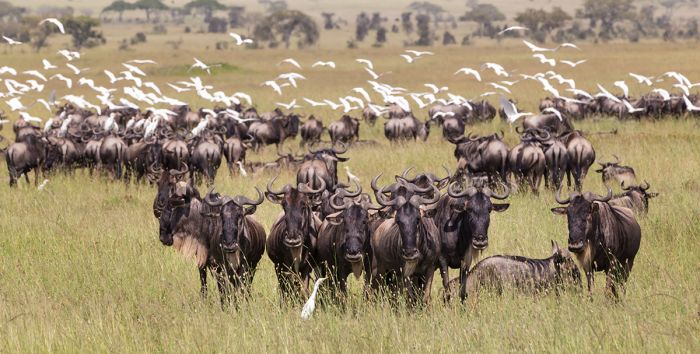
Wildebeests in the Great Migration.
The timing of the migration is rarely ever the same year-to-year, as local conditions influence grass growth and as such, the location of the bulk of there animals cannot be known precisely. Rains and other unknown conditions seem to direct the timing of the migration, but generally, it is known within several weeks when the animals will be in a general location.
The animals spread out to cover a vast area, but the main bulk of the animals moves south into the northern Serengeti around late-October and continue moving south towards the Serengeti's southern plains, arriving there sometime in January to graze on the rich grass growing on the volcanic soils. It is here on these short-grass plains, between January and early March, when the wildebeests give birth to their young en masse, producing some 500 000 baby wildebeests.
The herds remain on the southern short-grass plains until late March, giving the young animals time to grow and become strong, before heading north and west again. Many of the animals move towards the Serengeti's Western Corridor and Grumeti Reserve and the rest straight north into Central and Northern Serengeti, where they remain during June and into July. The herds move back into Kenya starting in late July, with the bulk moving into the Masai Mara in August.
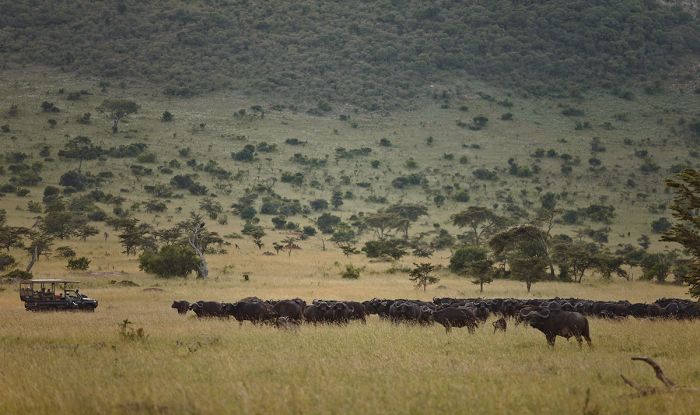
Safari drive at Klein's Camp and a large herd of buffalos.
Although many visitors time their visit to the Serengeti to coincide with the Migration, any region within the Serengeti offers very good wildlife viewing outside of the months when the migration may be present. This is because it is only the wildebeests and zebras that migrate, while the rest of the animals, including the major predators like lion, leopard, spotted hyena, and cheetah, as well as all the other herbivores, including springbok, gazelles, elephant, topi, hartebeest, and many others, do not migrate.
A popular aspect of experiencing the Great Migration is observing a herd as it crosses the Mara River, which requires animals swimming through waters inhabited by large Nile crocodiles that wait for a chance to get their first substantial meal in many months.
The dramatic river crossings (which take place along the Mara River in both Kenya and Tanzania) are certainly a spectacle and not for the faint of heart, with many of the wildebeest and zebras taken by crocs or succumbing to drowning or trampling in the chaos. The best chances for seeing a Grumeti River crossing is in June, while Mara River crossings are best in July and August.
ROOMS INCLUDES & EXCLUDES CHILDREN FACILITIES ACTIVITIES
Accommodation
10 guest accommodations in total comprising:
- 10 twin-bedded cottages, each with two three-quarter beds (separate mattresses with shared base). Mattress converters are available that transform the twin beds into a double bed. Two of the cottages are available as a triple (adult(s) and children 16 years and younger).
- Cottages 1 and 2 are connected by an enclosed inter-leading passage, which allows easy access between the cottages while maintaining complete privacy. When combined as a double cottage, this is ideal for a family or even two couples traveling together. When used by a family with children, the double cottage can accommodate two adults and two children (three children can be provided for on request).
All of the cottages are constructed of local stone and makuti thatch, with rich wooden floors and classic interiors. Every cottage includes en-suite facilities with a double-basin vanity, indoor shower, and toilet. The cottages are accessed via footpaths on the ground leading to the main camp area.
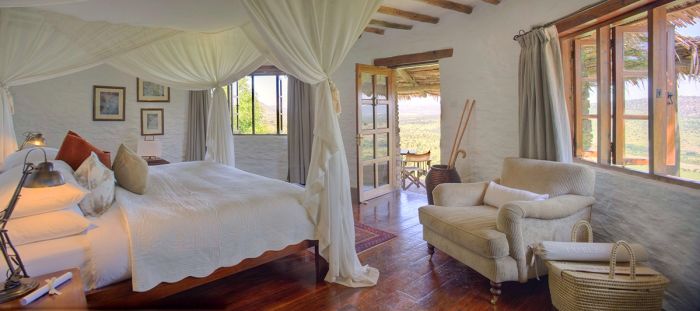
Guest cottage bedroom.
The camp and cottages are perched on the edge of the Kuka Hills. Each cottage has a private verandah offering spectacular views of the Klein Valley below.
The circular-shaped cottages are quaint but comfortably-sized, covering 463 square feet (43 sq meters) in area and well spaced, with a distance of 35-50 feet (11-15 meters) between each cottage.
Other items and features in the guest cottages include:
- Private veranda overlooking the Klein Valley.
- Gym-in-a-basket.
- Healing Earth treatments offered in-room.
- Personal bar.
- Complimentary pair of Swarovski binoculars (one per cottage).
- In-room Wi-Fi (also available in main guest area).
- Mosquito netting over the bed.
- Telephone (intermittent GSM mobile reception).
- Hairdryer.
- In-room safe.
Klein's Camp can accommodate a maximum of 22 guests in total: 2 persons in each of the 10 guest cottages with two cottages convertible to a triple.
Includes & Excludes
Includes:
- All meals and local beverages including soft drinks, house wines, local brand spirits and beers, teas, and coffees.
- Safari experiences (game drives, walking safaris, birding, and local community visit) accompanied by an experienced guide.
- Africa Foundation community visit.
- Laundry services are provided on a daily basis (weather permitting, items will be returned on the same day). Laundry is dried by the sun and on most days any laundry placed out in the morning will be returned by the evening.
- A complimentary pair of Swarovski Optik CL Companion 8×30 binoculars per cottage for use during your stay.
- Emergency medical evacuation insurance.
- Wi-Fi access.
- Tourism Levy & VAT.
Excludes:
- Hot-air ballooning (seasonal).
- Purchases from the Safari Shop.
- Champagne, cognacs, fine wines, premium brand spirits, and cigars.
- Spa / wellness treatments.
- Any applicable wildlife fee, park fee, reserve fee, concession fee, other land-use fee.
Single Supplement
A single supplement may apply for any room booked by a single traveler; please ask us for pricing.
Children
Families can rest assured that your children will always be safe and well cared for (both during activities and at the camp) by the camp staff.
Children of any age are accommodated at Klein's Camp:
- 1 triple available (in the family suite).
- Children under the age of 6 years are permitted only on a private vehicle or a children’s game drive (avoiding lion, leopard and elephants sightings), not during standard game drive time. No walks outside of the camp.
- Children aged 6-11 years are permitted on game drives at the discretion of the manager and guides (private vehicle required).
- Children aged 6-11 years are not permitted on nature walks outside of the camp grounds.
- Children aged 12-15 years are permitted on game drives (private vehicle required) and nature walks.
- Private vehicle not required for children aged 16 years and older.
- Children aged 16 and above are permitted on specialist walking safaris.
- Children that share a vehicle with other guests not in their party may be subject to activities only at the camp manager’s discretion.
- Please note: The camp is not fenced off and children are required to have an adult accompanying them at all times.
- While the camp does not have trained child minders, it can offer the services of certain staff members who are wonderful with children. This will be at an additional cost (best to pre-book this with us).
AndBeyond’s WILDchild programme, designed especially for children aged 3-12 years, is filled with fun, interactive activities that offer opportunities to learn and discover new experiences and cultures. Deeply rooted in the love for the African bush, it not only creates a series of unforgettable moments for the whole family, but forges strong bonds between young guests, our planet, and its people.
Wildchild activities include:
- Taking part in a Maasai obstacle course combining spear throwing, shooting bows, and making a fire the Maasai way.
- Embark on a nature walk with a ranger, identifying animal tracks.
- Baking delicious biscuits with the camp’s chefs.
Facilities
Set in a landscape that is gentle yet rugged, Klein's Camp reflects the heart of this untamed land with a vintage safari style. The stone interiors of the guest areas open up to breathtaking panoramas, with open fireplaces to keep the chill away. Featuring a beautifully furnished bar and sitting area, stone floors and deep leather armchairs invite you to while away the hours.
Main guest area facilities include:
- Two main structures: one has the bar and lounge and the other is used for dining.
- Located along the path to the cottages is a swimming pool with loungers and views to the valley below.
- Traditional boma for outdoor dining nights.
- Safari Shop.
- Complimentary Wi-Fi access (also available in the guest suites).
- Guest toilets in main area.
Activities
Activities included in the rate:
- Morning and afternoon/evening game drives in semi-open 4x4 Land Cruisers (6-seater).
- A complimentary pair of Swarovski Optik CL Companion 8×30 binoculars per guest cottage for use during your stay.
- Guided bush walks.
- Birding.
- Stargazing.
- WILDchild program for kids.
Optional activities at additional cost:
- Private activities are on offer (subject to vehicle availability, which needs to be booked in advance).
- Hot-air ballooning.
- Community visit to a local village.
- Wellness treatments (offered in-suite).
Example of a typical day:
- Early morning wake-up call. Morning wake-up and activity times vary according to the seasons, activities on offer, and wildlife sightings.
- Light breakfast before departing on the morning activity.
- Return to the lodge for a meal and rest period.
- Meet for afternoon tea and snacks (savory and sweet choices) before departing on the activity.
- Return to camp - freshen up or meet for drinks, followed by dinner.
- Enjoy a nightcap and/or discussion at the bar or around the campfire before retiring.
Great Good Fair Poor
- Jan
- Feb
- Mar
- Apr
- May
- Jun
- Jul
- Aug
- Sep
- Oct
- Nov
- Dec
General Tips
It is advised to avoid the Serengeti over March and April, when heavy rains typically occur. June to mid-October is excellent for general game viewing. The large herds of animals in the Great Migration usually cross into the Serengeti from Kenya's Masai Mara sometime around early October and move north back into Kenya around mid- to late-July.
Besides the Great Migration, the other big factor that impacts a stay in the Serengeti is rains. The region experiences most of its rain between November and May, but there are two somewhat distinct rain seasons, the 'short' rains and the 'long' rains (read more below).
Klein's Camp is open year-round.
Rains
Short Rains
The short rains occur for about one month sometime during November and December (the exact time varied somewhat year to year). This period is called the 'short' rains because the duration of an individual rain event is short and it is rare to have an all-day rain event. Most rain falls as an afternoon shower, while mornings are typically overcast or clear.
Long Rains
The long rains occur between March and May, with April being the wettest month of the year. During this time, rain should be expected almost every day and the showers can last for hours at a time, although all-day rain is not typical. The roads in the Serengeti become muddy and very difficult in places, which can hamper game drives. Cloudy skies are typical and temperatures can be chilly at times.
The period between the short and long rains (January and February) also receives rain, but many days are clear and the amount and duration of the rain events is unpredictable, with some afternoon showers and the odd long and heavy rainfall event.
Temperatures
The temperatures in the Greater Serengeti do not experience wide fluctuation throughout the year, as the region lies between one and three degrees south of the equator. In general, daytime temperatures are comfortably warm and overnights and early mornings are chilly. Bring a fleece and rain jacket regardless of the timing of your visit.
Dry Season
The dry season (June to October) is sunny and warm most days and rarely hot. Rare rain showers can occur but are unlikely. From June thru August, the afternoon temperature averages 76-78°F (24-25°C), but some days can be warmer. Evenings and early mornings temperatures are often chilly, averaging 53-55°F (12-13°C).
September and October days are very pleasant, with temperatures averaging 80-83°F (28-30°C), with cool mornings persisting, averaging 53-56°F (11-13°C).
Rainy Season
The rain season is November through May (read more above) and the temperatures are fairly static throughout the season. Daytime temperatures average 79-83°F (26-28°C) and nighttime and early morning temperatures are chilly, but slightly warmer than the dry season, averaging 54-57°F (12-14°C).
The Great Migration
The annual movement of wildebeest and zebras across the Serengeti-Mara ecosystem is one of the greatest spectacles in the natural world. These large herds move in a circular track across southern Kenya and northern Tanzania, taking a full year to complete their cycle. The migration moves across both the Greater Masai Mara (in Kenya) and the Greater Serengeti (in Tanzania) in a fairly consistent pattern and timeframe. The animals move to take advantage of fresh grasses on which to graze.
The migrating herds of roughly 1.5 million blue wildebeests and several hundred thousand plains zebras spend about nine months of the year moving through Tanzania's Greater Serengeti and the other three months in Kenya's Greater Masai Mara. The migrating herds are in Tanzania's Greater Serengeti from sometime in October until around late-July (note that the timing is never precise and varies somewhat year to year). Note that the Serengeti is vast, and it is important to note where in the region the herds are located during this nine-month timeframe.
The animals spread out to cover a vast area, but the main bulk of the animals moves south into the northern Serengeti around late-October and continue moving south towards the Serengeti's southern plains, arriving there sometime in January to graze on the rich grass growing on the volcanic soils. It is here on these short-grass plains, between January and early March, when the wildebeests give birth to their young en masse, producing some 500 000 baby wildebeests.
The herds remain on the southern short-grass plains until late March, giving the young animals time to grow and become strong, before heading north and west again. Many of the animals move towards the Serengeti's Western Corridor and Grumeti Reserve and the rest straight north into Central and Northern Serengeti, where they remain during June and into July. The herds move back into Kenya starting in late July, with the bulk moving into the Masai Mara in August.
The migration is rarely ever the same in terms of precise timing and direction, as local rains and other conditions influence grass growth. The wildebeest may, therefore, move off the open plains earlier in some years and remain in the northern Serengeti for longer in others. Nonetheless, the best months for seeing the migration in the Southern Serengeti are in February and March, when the herds are adding new babies, in the Central Serengeti during May and June, when the herds are the most concentrated, and in the Western Corridor, Grumeti, and far Northern Serengeti from June thru August.
Many visitors hope to witness dramatic river crossings, when hungry crocodiles attack the herds as they swim across the dangerous rivers of the Northern Serengeti. Like the migration in general, the precise timing of the river crossings is never known from year to year, but crossings on the Grumeti River are usually best in June, while Mara River crossings are best in July and August.




